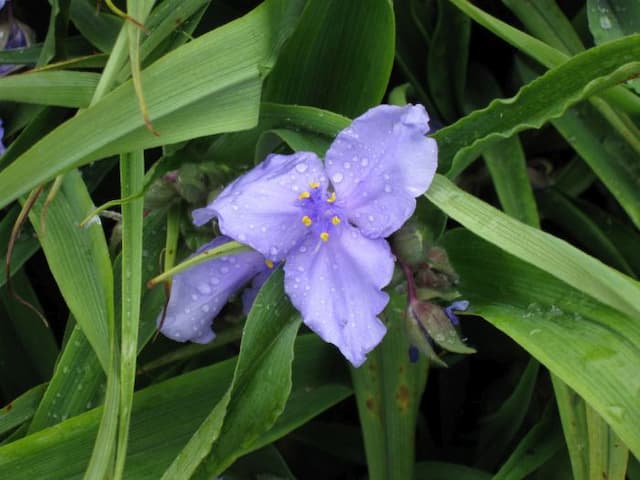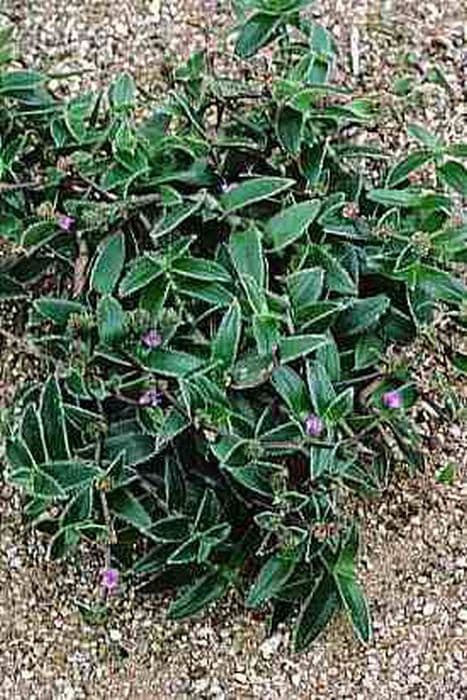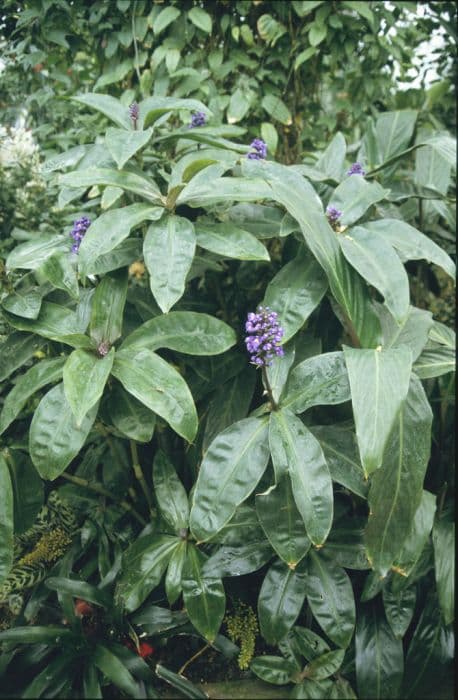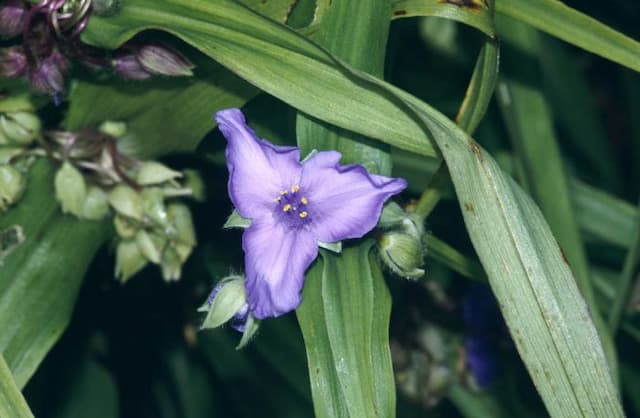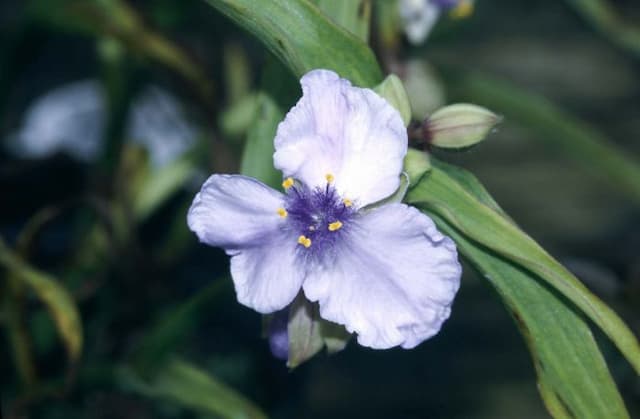Spiderwort Tradescantia (Andersoniana Group) 'Sweet Kate'
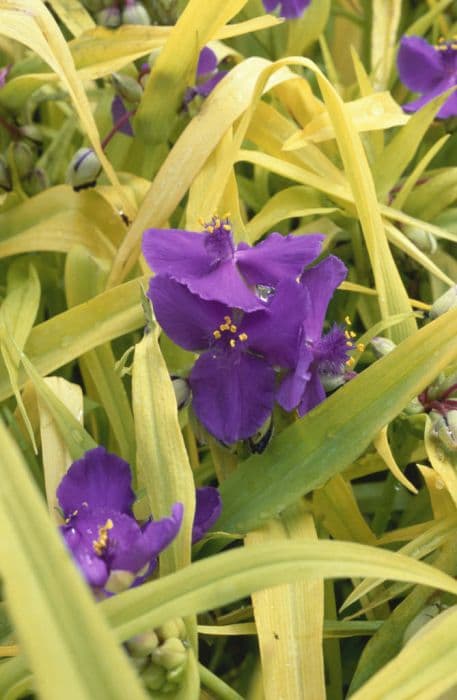
ABOUT
'Sweet Kate' is a vibrant and striking variety of Spiderwort that catches the eye with its bright features. The most distinctive aspect of 'Sweet Kate' is its foliage, which boasts a unique, electric golden-yellow color that can add a splash of brightness to any garden. The leaves are long and slender, with a slightly undulating edge that adds texture and visual interest. Complementing its vivid foliage, 'Sweet Kate' produces an abundance of delicate flowers that bring an additional layer of beauty to the plant. These blossoms are a deep, rich purple color with three petals each, and they contrast beautifully against the golden leaves. The flowers have a trio of bright yellow stamens at their center, which stand out and seem to glow against the purple petals. These delightful blooms, set above the foliage, gather in small clusters that add a soft, yet striking, display of color. As a perennial, 'Sweet Kate' returns each year to adorn gardens with its cheerful palette and is a favorite among gardeners for its easy-care nature and the lovely pop of color it provides.
About this plant
 Names
NamesFamily
Commelinaceae.
Synonyms
Spiderwort, Widow's Tears.
Common names
Tradescantia 'Sweet Kate'
 Toxicity
ToxicityTo humans
Spiderwort, including the 'Sweet Kate' variety, is not generally considered toxic to humans. However, if ingested in large quantities, it might cause mild gastrointestinal symptoms such as nausea, vomiting, or diarrhoea. These plants are primarily grown as ornamental plants and not for consumption, so it is always best to avoid eating any parts of ornamental plants due to potential allergic reactions or unforeseen toxicity.
To pets
Spiderwort is not known to be toxic to pets such as dogs and cats. This plant is generally considered safe around animals, and there should not be any major concerns if pets happen to ingest a small amount. However, as with any non-food plant, ingestion might lead to gastrointestinal upset, including symptoms like vomiting or diarrhoea, especially if consumed in larger amounts. Always monitor pets for any adverse reactions if they ingest plants not intended for consumption.
 Characteristics
CharacteristicsLife cycle
Perennials
Foliage type
Deciduous
Color of leaves
Green
Flower color
Purple
Height
1-2 feet (30-60 cm)
Spread
1-2 feet (30-60 cm)
Plant type
Herb
Hardiness zones
4-9
Native area
North America
Benefits
 General Benefits
General Benefits- Ornamental Appeal: The plant 'Sweet Kate' offers vibrant blue to purple flowers and contrasting bright yellow-green foliage that add aesthetic value to gardens.
- Low Maintenance: It is known for being a low-maintenance plant, making it suitable for gardeners of all skill levels.
- Pollinator Attraction: The flowers attract bees and butterflies, aiding in pollination and supporting local ecosystems.
- Tolerance to Various Conditions: 'Sweet Kate' can thrive in a range of soil types and can tolerate various light conditions from full sun to partial shade.
- Erosion Control: As a ground cover plant, it can help prevent soil erosion in garden beds and landscapes.
- Drought Resistance: Once established, it exhibits some drought tolerance, reducing the need for frequent watering.
- Seasonal Interest: This plant offers visual interest from spring to fall, with its bright foliage in spring and summer, and flower blooms in late spring or early summer.
- Versatility in Landscaping: 'Sweet Kate' can be used in borders, flower beds, containers, and as underplanting for taller plants, providing flexibility in garden design.
 Medical Properties
Medical PropertiesThis plant is not used for medical purposes.
 Air-purifying Qualities
Air-purifying QualitiesThis plant is not specifically known for air purifying qualities.
 Other Uses
Other Uses- Indicator Plant: Sweet Kate's foliage may change color in response to soil pH, which can be useful for gauging the acidity of the garden soil.
- Fairy Gardens: The vibrant foliage is often used to add a pop of color in miniature fairy garden landscapes.
- Photography Backdrop: The bright yellow leaves and purple flowers of Sweet Kate can serve as a beautiful natural backdrop for macro photography.
- Textile Dye: Historically, some Tradescantia species have been used to produce a natural greenish-yellow dye for fabrics.
- Crafts: Dried parts of Sweet Kate can be used in creating bookmarks, greeting cards, or other paper crafts.
- Education: Sweet Kate can be used in schools or educational programs to teach children about plant growth and chlorophyll production due to its distinctive coloration.
- Religious Symbolism: In some cultures, Tradescantia species are used in religious ceremonies and as symbols of perseverance and hope.
- Living Mulch: Sweet Kate can act as living mulch, with its dense growth helping to retain soil moisture and suppress weed growth.
- Color Contrast in Floral Arrangements: Sweet Kate can be used as a fresh addition to floral arrangements, providing a vibrant contrast to other flowers.
- Container Gardens: Sweet Kate is suitable for adding structure and color contrast when planted in containers with other shade-tolerant plants.
Interesting Facts
 Feng Shui
Feng ShuiThe Spiderwort, as Tradescantia is commonly known, is not traditionally used in Feng Shui practice.
 Zodiac Sign Compitability
Zodiac Sign CompitabilityThe Spiderwort is not used in astrology practice.
 Plant Symbolism
Plant Symbolism- Adaptability: Tradescantia, commonly known as the Spiderwort, can thrive in a variety of conditions, symbolizing the ability to adapt and flourish in diverse environments.
- Transience: Spiderwort flowers often last only for a day, highlighting the transient nature of life and the importance of appreciating every moment.
- Simplicity: The unassuming beauty of the Spiderwort reflects an appreciation for simple, understated elegance and the joy found in the everyday.
- Survival: As a hardy plant, Spiderwort symbolizes endurance and the will to survive even in challenging circumstances.
 Water
WaterSpiderwort 'Sweet Kate' prefers consistently moist soil but is tolerant of occasional dry spells. It should be watered when the top inch of soil feels dry to the touch. Provide water at the base of the plant to avoid wetting the foliage, which can help prevent disease. During active growth in spring and summer, watering might be necessary once or twice a week, depending on local weather conditions. Aim to provide about one gallon of water per week, adjusting for rainfall, to maintain moisture without causing waterlogging.
 Light
LightSpiderwort 'Sweet Kate' grows best in full sun to partial shade. Ideally, place it in a spot where it can receive morning sunlight and some afternoon shade, especially in hot climates. This plant can tolerate a few hours of direct sun, but the bright, indirect light will keep its foliage vibrant and prevent scorching.
 Temperature
TemperatureSpiderwort 'Sweet Kate' thrives in temperatures between 50 and 90 degrees Fahrenheit but can survive in temperatures as low as 10 degrees Fahrenheit and as high as 100 degrees Fahrenheit. The ideal temperature range for optimal growth is 60 to 75 degrees Fahrenheit. Ensure the plant is protected from extreme cold or heat stress for continued health.
 Pruning
PruningPrune Spiderwort 'Sweet Kate' to encourage bushier growth and to remove any faded or dead flowers to promote continued blooming. Pruning can be done as needed throughout the growing season but is best performed in the early spring or after the first flush of blooms has faded. Light shaping or removal of old foliage will keep the plant tidy and can stimulate new growth.
 Cleaning
CleaningAs needed
 Soil
SoilSpiderwort 'Sweet Kate' thrives in a moist, well-draining soil mix with good organic content. A mixture of loamy garden soil, peat, and perlite or sand is ideal, providing both moisture retention and drainage. This plant prefers a slightly acidic to slightly alkaline pH range of 5.5 to 8.0.
 Repotting
RepottingSpiderwort 'Sweet Kate' should be repotted every 2-3 years or when it outgrows its current pot to ensure continued growth and to refresh the soil.
 Humidity & Misting
Humidity & MistingSpiderwort 'Sweet Kate' prefers moderate to high humidity but is adaptable to average household humidity levels.
 Suitable locations
Suitable locationsIndoor
Place in bright, indirect light.
Outdoor
Partial sun to shade; moist, well-drained soil.
Hardiness zone
4-9 USDA
 Life cycle
Life cycleThe Spiderwort 'Sweet Kate' starts its life cycle when a seed germinates, typically in the spring, sprouting roots and shoots. The seedling stage follows, where the young plant develops its distinctive narrow, bright yellow-green foliage. As it matures into the vegetative stage, 'Sweet Kate' forms clumps with multiple leaf-bearing stems and enters a phase of growth and energy accumulation. During the flowering stage, usually in late spring to early summer, it produces clusters of vibrant, triangular, blue to purple flowers, which are highly attractive to pollinators. After pollination, the plant sets seed, which may drop to the ground to begin a new life cycle or be collected for propagation. In the dormant stage, occurring during the colder months, 'Sweet Kate' dies back to the ground, conserving energy in its roots for the next growing season.
 Propogation
PropogationPropogation time
Spring-Early Summer
Propogation: Tradescantia 'Sweet Kate', commonly known as Spiderwort, is commonly propagated through division, a process where the plant's clumps are separated into smaller pieces. The best time for division is in the spring or early fall when the plant is not in active bloom. To propagate by division, gently dig up the entire plant, making sure to keep a substantial amount of roots with each clump. Then, using a clean, sharp knife or garden shears, divide the root ball into sections, ensuring each section has several shoots and a healthy amount of root system attached. These sections can then be replanted into a well-prepared garden bed or pot with good soil mix, ensuring they are spaced at least 12 inches (approximately 30 centimeters) apart to allow for adequate growth. Keep the newly planted divisions well-watered and shaded for the first few days to help them establish in their new location.



